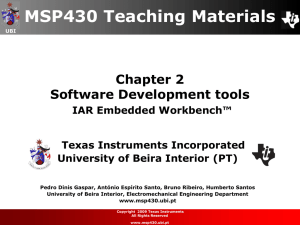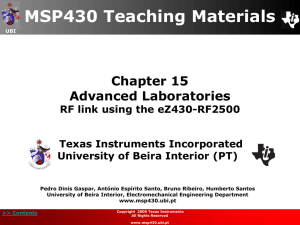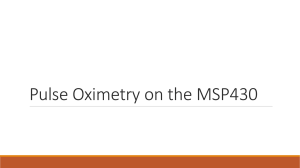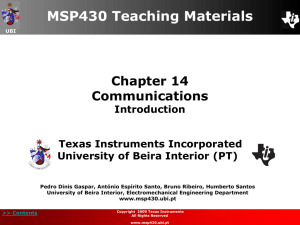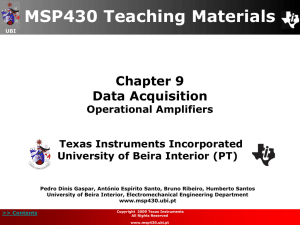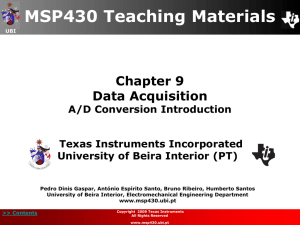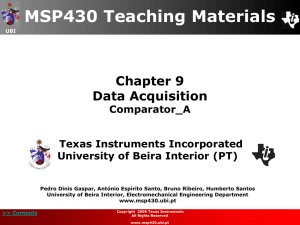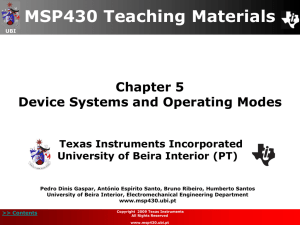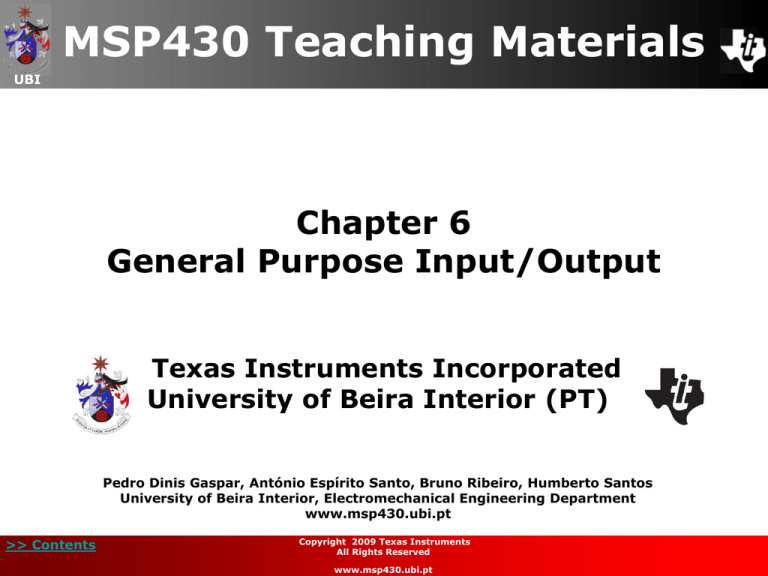
MSP430 Teaching Materials
UBI
Chapter 6
General Purpose Input/Output
Texas Instruments Incorporated
University of Beira Interior (PT)
Pedro Dinis Gaspar, António Espírito Santo, Bruno Ribeiro, Humberto Santos
University of Beira Interior, Electromechanical Engineering Department
www.msp430.ubi.pt
>> Contents
Copyright 2009 Texas Instruments
All Rights Reserved
www.msp430.ubi.pt
Contents
UBI
Introduction
I/O port registers
Interruptible ports
Laboratory 2: Blinking the LED:
Lab2A: Blinking the LED
LAB2B: Blinking the LED at ½ speed
Lab2C: Toggle the LED state by button press
Lab2D: Enable/disable LED blinking by button press
Quiz
>> Contents
Copyright 2009 Texas Instruments
All Rights Reserved
www.msp430.ubi.pt
2
Introduction (1/3)
UBI
Up to ten 8-bit digital Input/Output (I/O) ports, P1 to P10
(depending on the MSP430 device);
I/O ports P1 and P2 have interrupt capability;
Each interrupt for these I/O lines can be individually
configured:
To provide an interrupt on a rising or falling edge;
All interruptible I/O lines source a single interrupt vector.
The available digital I/O pins for the hardware
development tools:
eZ430-F2013: 10 pins - Port P1 (8 bits) and Port P2 (2 bits);
eZ430-RF2500: 32 pins - Port P1 to P4 (8 bits);
Experimenter’s board: 80 pins – Port P1 to P10 (8 bits).
>> Contents
Copyright 2009 Texas Instruments
All Rights Reserved
www.msp430.ubi.pt
3
Introduction (2/3)
UBI
Each I/O port can be:
Programmed independently for each bit;
Combine input, output, and interrupt functionality;
Edge-selectable input interrupt capability for all 8 bits of
ports P1 and P2;
Read/write access to port-control registers is supported by
all two- or one-address instructions;
Individually programmable pull-up/pull-down resistor (2xx
family only).
>> Contents
Copyright 2009 Texas Instruments
All Rights Reserved
www.msp430.ubi.pt
4
Introduction (3/3)
UBI
The port pins can be individually configured as I/O for
special functions, such as:
USART – Universal Synchronous/Asynchronous
Receive/Transmit for serial data;
Input comparator for analogue signals;
Analogue-to-Digital converter;
Others functions (see specific datasheet for details).
>> Contents
Copyright 2009 Texas Instruments
All Rights Reserved
www.msp430.ubi.pt
5
Registers (1/6)
UBI
Independent of the I/O port type (non-interruptible or
interruptible), the operation of the ports is configured
by user software, as defined by the following registers:
Direction Registers (PxDIR):
• Read/write 8-bit registers;
• Select the direction of the corresponding I/O pin,
regardless of the selected function of the pin (general
purpose I/O or as a special function I/O);
• For other module functions, must be set as required by
the other function.
• PxDIR configuration:
Bit = 1: the individual port pin is set as an output;
Bit = 0: the individual port pin is set as an input.
>> Contents
Copyright 2009 Texas Instruments
All Rights Reserved
www.msp430.ubi.pt
6
Registers (2/6)
UBI
Input Registers (PxIN):
• When pins are configured as GPIO, each bit of these
read-only registers reflects the input signal at the
corresponding I/O pin;
• PxIN configuration:
Bit = 1: The input is high;
Bit = 0: The input is low;
• Tip: Avoid writing to these read-only registers because
it will result in increased current consumption.
>> Contents
Copyright 2009 Texas Instruments
All Rights Reserved
www.msp430.ubi.pt
7
Registers (3/6)
UBI
Output Registers (PxOUT):
• Each bit of these registers reflects the value written to
the corresponding output pin.
• PxOUT configuration:
Bit = 1: The output is high;
Bit = 0: The output is low.
– Note: the PxOUT Register is read-write. This means
that the previous value written to it can be read
back and modified to generate the next output
signal.
>> Contents
Copyright 2009 Texas Instruments
All Rights Reserved
www.msp430.ubi.pt
8
Registers (4/6)
UBI
Pull-up/down Resistor Enable Registers (PxREN):
• Only available for the 2xx family;
• Each bit of this register enables or disables the pullup/pull-down resistor of the corresponding I/O pin.
• PxREN configuration:
– Bit = 1: Pull-up/pull-down resistor enabled;
– Bit = 0: Pull-up/pull-down resistor disabled.
– When pull-up/pull-down resistor is enabled:
– In this case Output Registers (PxOUT) select:
» Bit = 1: The pin is pulled up;
» Bit = 0: The pin is pulled down.
>> Contents
Copyright 2009 Texas Instruments
All Rights Reserved
www.msp430.ubi.pt
9
Registers (5/6)
UBI
Function Select Registers: (PxSEL) and (PxSEL2):
• Some port pins are multiplexed with other peripheral
module functions (see the device-specific datasheet);
• These bits: PxSEL and PxSEL2 (see specific device
datasheet), are used to select the pin function:
– I/O general purpose port;
– Peripheral module function.
• PxSEL configuration:
Bit = 0: I/O Function is selected for the pin;
Bit = 1: Peripheral module function enabled for pin.
>> Contents
Copyright 2009 Texas Instruments
All Rights Reserved
www.msp430.ubi.pt
10
Registers (6/6)
UBI
Function Select Registers: (PxSEL) and (PxSEL2):
• The 2xx family of devices provide the PxSEL2 bit to
configure additional features of the device;
• The PxSEL and PxSEL2 bits in combination provide the
following configuration:
– Bit = 0: I/O function is selected for the pin;
– Bit = 1: Peripheral module function is selected for
the pin.
PxSEL
PxSEL2
Pin Function
0
0
Selects general purpose I/O function
0
1
Selects the primary peripheral module function
1
0
Reserved (See device-specific data sheet)
1
1
Selects the secondary peripheral module function
Note: P1 and P2 configured as peripheral module function (PxSEL = 1 and/or PxSEL2) -> interrupts disabled.
>> Contents
Copyright 2009 Texas Instruments
All Rights Reserved
www.msp430.ubi.pt
11
Interruptible ports (P1 and P2)
(1/2)
UBI
Each pin of ports P1 and P2 is able to make an interrupt
request;
Pins are configured with additional registers:
Interrupt Enable (PxIE):
• Read-write register to enable interrupts on individual pins;
• PxIE configuration:
Bit = 1: The interrupt is enabled;
Bit = 0: The interrupt is disabled.
• Each PxIE bit enables the interrupt request associated with
the corresponding PxIFG interrupt flag;
• Writing to PxOUT and/or PxDIR can result in setting PxIFG.
>> Contents
Copyright 2009 Texas Instruments
All Rights Reserved
www.msp430.ubi.pt
12
Interruptible ports (P1 and P2)
(2/2)
UBI
Interrupt Edge Select Registers (PxIES):
• Selects the transition on which an interrupt occurs (if PxIE
and GIE are set);
• PxIES configuration:
Bit = 1: Interrupt flag is set on a high-to-low transition;
Bit = 0: Interrupt flag is set on a low-to-high transition.
Interrupt Flag Registers (PxIFG)
• Set automatically when an the programmed signal
transition (edge) occurs;
• PxIFG flag can be set and must be reset by software.
• PxIFG configuration:
Bit = 0: No interrupt is pending;
Bit = 1: An interrupt is pending.
>> Contents
Copyright 2009 Texas Instruments
All Rights Reserved
www.msp430.ubi.pt
13
Laboratory 2: Blinking the LED
UBI
Configure the I/O ports to use inputs from push buttons
to control the output lines feeding LEDs;
The following exercises have been developed for the
hardware development tools:
Experimenter’s board;
eZ430-RF2500;
eZ430-2013.
The main differences between these development tools
are the specific ports used for the input push buttons
and output LEDs.
>> Contents
Copyright 2009 Texas Instruments
All Rights Reserved
www.msp430.ubi.pt
14
Lab2A: Blinking the LED (1/6)
UBI
Procedure:
Check schematics for LED port location (Consult the
Hardware Development Tool User's Guide);
Port control registers:
• Set LED pin port as an output;
• Switch the port state between low and high state during
program execution.
Configure the watchdog timer to prevent a Power-Up Clear
(PUC);
Use an infinite loop to modify the state of the port;
Use a software delay loop to generate the pause interval (a
software delay loop with a long time period is used here for
simplicity - in real applications a timer would be used).
>> Contents
Copyright 2009 Texas Instruments
All Rights Reserved
www.msp430.ubi.pt
15
Lab2A: Blinking the LED (2/6)
UBI
MSP-EXP430FG4618
SOLUTION
Using the MSP-EXP430FG4618 Development Tool and the MSP430FG4618
device, blink LED1.
• Schematics:
>> Contents
Copyright 2009 Texas Instruments
All Rights Reserved
www.msp430.ubi.pt
16
Lab2A: Blinking the LED (3/6)
UBI
MSP-EXP430FG4618
SOLUTION
Using the MSP-EXP430FG4618 Development Tool and the MSP430FG4618
device, blink LED1.
LED1 is connected to Port 2.2;
Port control registers:
P2DIR:
• Port 2.2 is set as an output: P2DIR |= 0x04 {to force the
pin setting, an OR operation ( | ) is performed using
P2DIR and 0x04. This makes bit 2 -> 1, without affecting
any other port pins. }.
P2OUT: P2OUT ^= 0x04;
• To switch the port state between low and high states, an
XOR operation ( ^ ) is performed using P2OUT and 0x04.
This reads the value previously written to P2OUT and
makes bit 2 change state from 0 -> 1 and 1 -> 0.
>> Contents
Copyright 2009 Texas Instruments
All Rights Reserved
www.msp430.ubi.pt
17
Lab2A: Blinking the LED (4/6)
UBI
MSP-EXP430FG4618
SOLUTION
Using the MSP-EXP430FG4618 Development Tool and the MSP430FG4618
device, blink LED1.
To prevent a PUC, the watchdog timer:
Must be stop and write 0x5A to the eight MSBs of the
Watchdog Timer Control Register, WDTCTL:
WDTCTL = WDTHOLD | WDTPW
Since no clock has been defined, the device will use a
32.768 kHz watch crystal:
To implement a blinking LED rate of one transition per
second, the software delay loop should count to
approximately 30000 {30000/32768 1 sec}.
>> Contents
Copyright 2009 Texas Instruments
All Rights Reserved
www.msp430.ubi.pt
18
Lab2A: Blinking the LED (5/6)
UBI
eZ430-RF2500
SOLUTION
Using the eZ430-RF2500 Development Tool, blink the red LED.
The LED1 is connected to Port 1.1;
The programming code follows the
same sequence as given for the
MSP-EXP430FG4618, requiring
only configuration of this port pin.
>> Contents
Copyright 2009 Texas Instruments
All Rights Reserved
www.msp430.ubi.pt
19
Lab2A: Blinking the LED (6/6)
UBI
eZ430-F2013
SOLUTION
Using the Ez430-F2013 Development Tool, blink the LED.
The LED is connected to Port 1.0;
The programming code follows the
same sequence as given for the
MSP-EXP430FG4618, requiring
only configuration of this port pin.
>> Contents
Copyright 2009 Texas Instruments
All Rights Reserved
www.msp430.ubi.pt
20
Lab2B: Blinking the LED 1/2 the speed
UBI
Procedure:
Using the previous example as a starting point, re-write the
code to reduce the value of the software delay to half its
previous value;
As the LED changes state once per second, the software
delay loop should count to approximately 15000
{15000/32768 0.5 sec}.
>> Contents
Copyright 2009 Texas Instruments
All Rights Reserved
www.msp430.ubi.pt
21
UBI
Lab2C: Toggle the LED state by pressing the
button (1/5)
Procedure:
Analyse the schematics for the locations of the ports used
for the LED and button S1 (Consult the Hardware
Development Tool User's Guide);
Port control registers:
• Set button pin port as an input;
• Enable interrupts on this port pin.
Configure the watchdog timer to prevent a PUC;
Configure a low power mode.
>> Contents
Copyright 2009 Texas Instruments
All Rights Reserved
www.msp430.ubi.pt
22
UBI
Lab2C: Toggle the LED state by pressing the
button (2/5)
MSP-EXP430FG4618
SOLUTION
Use the S1 button of the development tool to toggle the state of LED1. You
must use interrupts to detect the button press and you should ensure that
the MSP430 is in Low Power Mode 3 when it is not in use.
LED1 configuration is given in Lab 2A;
Button S1 is connected to Port 1.0;
Port control registers:
P1DIR:
• Port 1.0 is set as an input: P1DIR &= ~0x01 {to force the pin
setting to 0, it uses an AND operation ( & ) between P1DIR and
0xFE}.
>> Contents
Copyright 2009 Texas Instruments
All Rights Reserved
www.msp430.ubi.pt
23
UBI
Lab2C: Toggle the LED state by pressing the
button (3/5)
MSP-EXP430FG4618
SOLUTION
Use the S1 button of the development tool to toggle the state of LED1. You
must use interrupts to detect the button press and you should ensure that
the MSP430 is in Low Power Mode 3 when it is not in use.
Port control registers:
P1IE:
• Enable interrupt to port 1.0.
PIIES:
• Call the port interrupt in a high-to-low transition.
Configure Watchdog timer.
>> Contents
Copyright 2009 Texas Instruments
All Rights Reserved
www.msp430.ubi.pt
24
UBI
Lab2C: Toggle the LED state by pressing the
button (4/5)
MSP-EXP430FG4618
SOLUTION
Use the S1 button of the development tool to toggle the state of LED1. You
must use interrupts to detect the button press and you should ensure that
the MSP430 is in Low Power Mode 3 when it is not in use.
Enable Global Interrupts;
Configure the low power mode 3;
Create an ISR, that includes:
Toggle LED1 pin port;
Delay for button debounce;
Clear interrupt flag.
>> Contents
Copyright 2009 Texas Instruments
All Rights Reserved
www.msp430.ubi.pt
25
UBI
Lab2C: Toggle the LED state by pressing the
button (5/5)
eZ430-RF2500
SOLUTION
Use the button of the development tool to toggle the state of the red LED.
You must use interrupts to detect the button press and you should ensure
that the MSP430 is in Low Power Mode 3 when it is not in use.
Follow the same sequence as given previously, taking
note that:
Button S1 is connected to Port 1.2.
Port control registers:
• The eZ430-RF2500 uses a device in the 2xx family, so
you need to additionally configure the Port 1.2 with a
pull-up or pull-down, in the P1REN register.
>> Contents
Copyright 2009 Texas Instruments
All Rights Reserved
www.msp430.ubi.pt
26
Lab2D: Enable/disable LED blinking by
button press (1/3)
UBI
Procedure:
Improve the last exercise (Lab 2C) to enable the LED
blinking with a button press;
Use the previous configuration;
Include a control flow program variable that detects
whether the LED is blinking or not when the button is
pressed.
>> Contents
Copyright 2009 Texas Instruments
All Rights Reserved
www.msp430.ubi.pt
27
UBI
Lab2D: Enable/disable LED blinking by
button press (2/3)
MSP-EXP430FG4618
SOLUTION
Use the S1 button of the development tool to start and stop the LED
blinking. It is not necessary to use Lower Power Modes in this exercise.
Follow the same sequence as given in Lab 2C;
Detect if the button is pressed: if (!(P1IN & 0x01));
Define a variable that indicates whether the LED is
blinking;
Set the program flow depending on the state of this
variable.
>> Contents
Copyright 2009 Texas Instruments
All Rights Reserved
www.msp430.ubi.pt
28
UBI
Lab2D: Enable/disable LED blinking by
button press (3/3)
eZ430-RF2500
SOLUTION
Use the button in the development tool to start and stop the LED blinking. It
is not necessary to use Low Power Modes in this exercise.
Follow the same sequence as given in Lab 2C for this
hardware development tool and the additional steps
provided above.
>> Contents
Copyright 2009 Texas Instruments
All Rights Reserved
www.msp430.ubi.pt
29
Quiz (1/4)
UBI
In the MSP430 system all I/O ports:
(a) Are initially set as outputs when the system powers up;
(b) Remain constant as the application program proceeds;
(c) Vary with each step of the program;
(d) Are initially set as inputs when the system powers up.
2. To set an I/O port pin as output, the:
(a) PxDIR direction register bit is set;
(b) PxSEL function-select register bit is set;
(c) PxIN register bit is set;
(d) PxOUT register bit is set.
>> Contents
Copyright 2009 Texas Instruments
All Rights Reserved
www.msp430.ubi.pt
30
Quiz (2/4)
UBI
3. An input pin on the MSP430 I/O port configuration
requires:
(a) Reset the direction register bit, if it previously was set;
(b) Set the PxIN register bit to whatever the input data
dictates;
(c) PxOUT register bit inactive;
(d) All of above.
4. For the 2xx family hardware development tools
(eZ430-F2013 and eZ430-RF2500), an output pin is
pulled down when:
(a) PxDIR and PxREN are set;
(b) PxDIR is set, PxREN is reset;
(c) PxDIR, PxREN and PxOUT are set;
(d) PxDIR and PxOUT are reset.
>> Contents
Copyright 2009 Texas Instruments
All Rights Reserved
www.msp430.ubi.pt
31
Quiz (3/4)
UBI
5. The eZ430-F2013 Port 1 I/O pin as Sigma/Delta ADC
(SD16_A) positive analogue input A0 requires:
(a) Set P1SEL bit 0 and P1DIR bit 0;
(b) Set P1OUT bit 1 and reset P1DIR bit 1;
(c) Set P1IN bit 2 and reset P1DIR bit 2;
(d) Set P1SEL bit 1 and reset P1DIR bit 0.
6. To configure an I/O Port 2 to generate an interrupt
request during an low-to-high transition:
(a) Set the P2DIR, P2IE and P2IES associated bits;
(b) Set the P2IE associated bit and reset the P2DIR and P2IES
associated bits;
(c) Set the P2IE and P2DIR associated bits and reset the P2IES
associated bits;
(d) None of the above.
>> Contents
Copyright 2009 Texas Instruments
All Rights Reserved
www.msp430.ubi.pt
32
Quiz (4/4)
UBI
Answers:
1. (d) Are initially set as inputs when the system powers up.
2. (a) PxDIR direction register bit set.
3. (a) Reset the direction register bit, if it was previously set.
4. (b) PxDIR is set, PxREN is reset.
5. (a) Set P1SEL bit 0 (P1SEL = 0x01h) and P1DIR bit 0
(P1DIR = 0x01h).
6. (b) Set the P2IE associated bit and reset the P2DIR and
P2IES associated bits.
>> Contents
Copyright 2009 Texas Instruments
All Rights Reserved
www.msp430.ubi.pt
33


